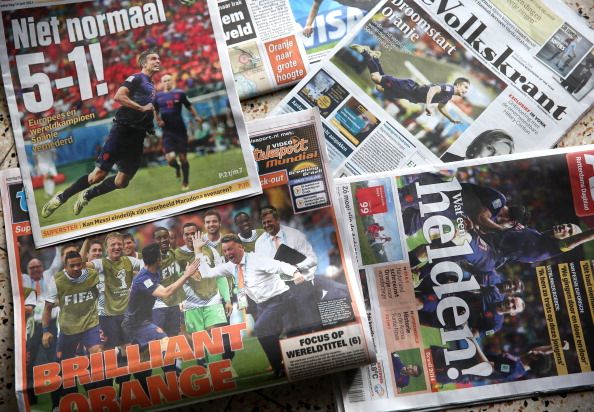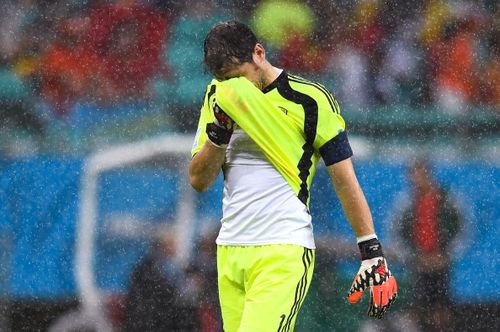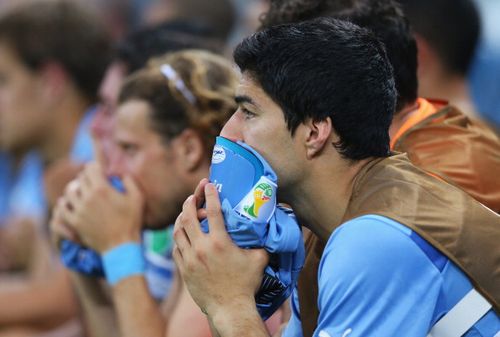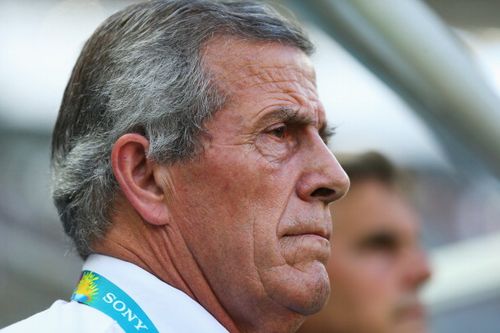
Excess baggage from South Africa hurting, rather than helping, Spain and Uruguay's chances

The word out on the streets (not just those in Brazil) is that World Cup 2014 is turning out to be the best ever in the history of the event. We’re just six days in and there have already been so many memorable moments that it has outshone some of its predecessors. There has been the notable emphasis on attack by almost all teams, with caution being thrown to the wind and teams not settling for comfortable draws early on, England not lumping long balls forward for a change...
That in turn has led to a glut of goals, the key fuel that keeps interest levels going at such a massive event, especially when fans have to stay up long into the night in most parts of the world. But, over and above those, there have been the upsets, the results that send audiences into a frenzy and those that initiate arguments and counter-arguments that run for days after the actual result. And unfortunately for Spain and Uruguay, they have been the victims of those upsets at Brazil 2014.
How did this happen? Both of the results were inconceivable before the tournament began. However, a closer look suggests that perhaps we shouldn’t be so surprised at what transpired in Salvador and Fortaleza last week. Perhaps Spain’s drubbing at the hands of the Dutch and Uruguay’s insipid display against a spirited Costa Rica side was in the works even before they stepped onto the pitch?
Spain and Uruguay were two of the final four at the last edition in South Africa in 2010; Spain the victors while Uruguay finished a very impressive fourth. But both these teams seem to have overlooked a key aspect in their preparations for this World Cup, something that the other two from the final four in South Africa (Netherlands and Germany) seem to have taken note of and duly addressed.
Both of these teams have carried with them excess baggage from the previous World Cup and it is hurting them.
Spain
World and European champions Spain were spoilt for choice in terms of talent, not just in picking a 23-man squad, but also a provisional 30-man squad for that matter. The squad has some visible new faces, but the team that took to the field against the Netherlands resembled much the same to the one from four years ago.
There were four notable changes from the team that started the final at the previous edition – Diego Costa was employed as the lone striker up front in place of David Villa, Jordi Alba took up the left-back role, previously donned by the ultra-solid Joan Capdevila, David Silva came into the starting line-up in place of Pedro Rodriguez and Sergio Ramos moved to centre-back, from his erstwhile right-back position, taking over from Carles Puyol.
The old adage is to not fix something that isn’t broke, but while the Spanish squad and system wasn’t exactly broken, there were some tweaks that were necessary. One important thing to always look at is the stage at which a particular player’s career lifecycle lies.
Xavi and Xabi Alonso together in midfield was problem number one for Spain. While Xavi’s short-passing keeps things ticking over and Alonso’s ranging aerials open the game up when it becomes congested in midfield, the duo together are slow and as such, liable to be neutralized by a midfield high on energy and industry. Xavi is into the twilight years of a very successful career and Alonso too cannot hold a midfield on his own.
Diego Costa, after his fantastic season and allegiance switch to Spain, was going to be the first-choice striker. Plus, he offered something different from their previous two forward line leaders in good heading ability along with a knack for hassling opposing defenders.
However, Costa hasn’t exactly had the best of time in the last one-and-a-half months or so prior to the tournament, with the injury he suffered and the resultant rustiness. He looked very off the pace against the Dutch despite winning the penalty for Spain’s goal. But playing him was the right thing to do; what wasn’t was picking able alternatives.
Villa showed this season that he still has plenty of game left in him, but he is the kind of striker known more for his runs behind the defence and predatory instincts. Torres, a favourite of Coach Vicente Del Bosque, expectedly made the plane to Brazil, but in terms of his career graph, he is a player who has fallen way off the charts; his glaring miss during the game, further evidence of this.
Fernando Llorente, picked for South Africa, was overlooked this time, largely due to his marginalized role at Juventus. But he should have ideally made the trip for he offers something different to Torres and Villa.

In defence, the combination of Sergio Ramos and Gerard Pique at the back was run ragged by the Dutch offense. Pique is a defender who gets more credit than necessary; while he may be good in the air and at set pieces, he struggles mightily against pacy forwards for he can’t keep up with them in foot-speed. He has the turning radius of a truck which allows attackers to twist him one way and then the other, eventually putting him off balance and leaving him out of position. And him going up against one of the world’s premier attackers in Arjen Robben was always going to yield only one result – disaster.
Watching Robben go at him was like watching a hot knife cut through butter, like a nightmarish re-run for Spanish fans of when Bayern Munich dismantled Barcelona, when Robben had put Pique to the sword as in Salvador. Having seen how this particular matchup played out in the past, it was surprising that Del Bosque didn’t opt for more cover, perhaps with the use of Javi Martinez.
Ramos to his credit was often found making some last ditch interceptions, without which, the score-line could have been worse for the champs. But Ramos too in the past couple of seasons has been undone when the opponents have attacked him with high pace and a bullish centre forward. Jürgen Klopp’s Borussia Dortmund, twice in two seasons, took Ramos’ Real Madrid defence to the cleaners. But the difference lay in that Ramos had Pepe, a mobile central defensive partner, to help him out at Real, which isn’t the case at national level.
The decline has continued with captain and keeper Iker Casillas as well, one noticed by Jose Mourinho, enough to convince him to drop Casillas. For all the ire that he earned at the hands of the Spanish press for that, he must feel vindicated now.

To go with that, Spain’s phenomenal run in world football also coincided with a successful period for Barcelona domestically and in Europe, a team whose players have come to form the core of the Spanish side. But since their second Euro success, the Catalan giants have found their dominance challenged and a system to combat their effective “tiki-taka” has been unearthed by more than one manager.
And that system has been beaten with the use of a directness in attack coupled with pace and shackling of the midfield engine room, where Xavi, Iniesta and Sergio Busquets operate; the very same elements that Louis Van Gaal employed with his Dutch side. Spain’s midfield quartet are no longer the all-conquering force that they used to be and with the defeats they’ve suffered in the last few years, so has their confidence.
Uruguay
Shifting the spotlight to South America and a very similar situation prevails with Uruguay. The squad almost resembles a carbon copy of the one that travelled to South Africa four years ago with a few exceptions. Oscar Tabarez and the Uruguayans have again erred along the same lines, much like Spain have. Diego Forlan is no longer the force he once was; going into the 2010 edition, Forlan was at the peak of his powers, amongst the top forwards in the game, plundering and setting up goals for Atletico Madrid. And he led the line beautifully for the South Americans, proving to be a key cog in their fourth place finish.
He is now 35 years old, and while age doesn’t necessarily always diminish a player’s capabilities, as exemplified by the peerless Andrea Pirlo, in Forlan’s case it has. He now plays for Cerezo Osaka and is nowhere near the levels he was at previously.

Edinson Cavani found himself isolated and frustrated with a lack of service from his midfield and the second striker in Forlan. The midfield that started the game, as Tabarez played a 4-4-2, comprised of Arevalo Rios, Walter Gargano, Cristian Rodriguez and Christian Stuani, and they were utterly listless, offering hardly any incisiveness in attack.
And with forwards who struggled to create openings by themselves, the absence of Luis Suarez was all the more debilitating. In their previous campaign, despite the three-pronged attack up front it was the solidity of their midfield and defence that propelled a good portion of their success, as Cavani and Suarez at the time had still not peaked.
Their midfield was held together by the veteran Diego Perez while Alvaro Pereira provided some much needed thrust with his runs from midfield. And in defence, the two Diegos – Godin and Lugano – were watertight. Lugano, another one who is now 35, is no longer the rock in defence he once was and while Godin is right up there among the top three central defenders in the world, his captain and partner in that area makes far too many mistakes these days.
These problems just didn’t explode in their faces in the first match against Costa Rica. They plagued the team right through its qualification campaign, one of the reasons why they struggled before eventually finishing fifth and making it through the playoffs. Uruguay relied heavily on Suarez’s proficiency in front of goal and the striker’s 11 goals (he was top-scorer in the CONMEBOL qualifiers) got his team into fifth place.
Another key stat was that while Uruguay scored 25 goals, they conceded an equal number, making for a goal difference of zero; the lowest among all qualifiers from South America.

No one knows why Tabarez didn’t employ either of Alvaro Pereira or Gaston Ramirez in the opener against Costa Rica. Was he resting his key players ahead of the clashes against England and Italy? If that was the case, was Tabarez underestimating the Costa Ricans? The most damning stat from that game was that a defender had the most number of passes (67); that happened to be their left-back Martin Caceres, who to his credit, was the most hardworking player on the day for the South American giants and did his best to spark his team’s attack. Maxi Pereira had the second-highest (65) indicating Uruguay’s reliance on their full-backs when in possession.
There are still two games to go – Chile and England loom
While things didn’t exactly go right for these two teams, there is still time for them to set it right. Spain take on Chile in their second game later tonight, in what is a must-win encounter, with Chile having won their opener. It is a rematch from the last World Cup where the two teams met in the group stage with Spain coming out 2-1 winners. The defending champions have the personnel necessary to give their team a different look.
Del Bosque might consider switching to his forward-less line-up that worked so well at the Euros, employing Cesc Fabregas as the advanced man. Also Juanfran for Azpilicueta at right-back may be a move worth considering for the Atletico Madrid man is sounder defensively and is a smart operator in being able to bomb forward in support of his teammates. Also, the younger Koke to partner Xabi Alonso in midfield while withdrawing Xavi, is a move that could be on the cards as Del Bosque has not shied away from making changes in the past.

For Uruguay, Suarez in all likelihood will take to the field against England tomorrow night and that should give his compatriots a huge shot in the arm along with some much needed motivation. Elsewhere, Tabarez has to consider making a change in his midfield too. Either of Stuani or Rodriguez will make way for Suarez, but the coach might as well replace the remaining one also with someone like Ramirez or Alvaro Pereira.
It has been one loss only for both these teams; just three points surrendered. Both have two matches remaining to right their ship in time before the opportunity to get to the knockout rounds slips away from their grasp. They have made similar mistakes to past champions in France (2002) and Italy (2010) in failing to refresh their squads and believing that continuity will ensure success.
However, they must not continue with that beaten path but rather make smart adjustments because otherwise they will suffer the same fate as France and Italy and be heading home by the time the Round of 16 comes along. They will both face opponents playing a brand of football suited to exploiting their weaknesses, but with the right adjustments, they can overcome the challenge.
All of the footballing world’s eyes will be on them to see if they can do just that and pick themselves up from the early punches that they have taken at Brazil 2014. Two nations in particular will watch on with expectant eyes.